Ba'athist Syria
Major protests against Ba'athist rule in 2011 during the Arab Spring led to the Syrian civil war between opposition forces, government, and in following years islamists such as ISIS which weakened the Assad regime's territorial control.
Politicians, military officers and civilians who supported Syria's secession from UAR were also stripped of their social and legal rights by the Ba'athist-controlled National Council for the Revolutionary Command (NCRC); thereby enabling the Ba'athist regime to dismantle the entire political class of the Second Syrian Republic and eliminate its institutions.
[20] Following the seizure of power in 1963 by the neo-Ba'athist military committe, the Syrian regional branch of the Ba'ath party experienced severe factionalism and splintering, leading to a succession of governments and new constitutions.
Civilian wing of the Ba'ath party, consisting of classical Ba'athists led by Aflaq and Bitar, had little influence over the ideological direction of the Syrian regional branch.
[28] The pro-Marxist resolutions and declarations, such as the espousal of "class struggle" and "scientific socialism", adopted by the Ba'ath party during its 6th national congress set the ideological foundation of neo-Ba'athism.
They also carried out purges within the Syrian Arab Armed Forces, as part of their efforts to subordinate the civilian old guard of the National Command of the Ba'ath Party and create an "ideological army" that was loyal to neo-Ba'athist officers.
[30][31][32] On 23 February 1966, the neo-Ba'athist Military Committee carried out an intra-party rebellion against the Ba'athist Old Guard (Aflaq and Bitar), imprisoned President Amin al-Hafiz and designated a regionalist, civilian Ba'ath government on 1 March.
[17] Although Nureddin al-Atassi became the formal head of state, Salah Jadid was Syria's effective ruler from 1966 until November 1970,[33] when he was deposed by Hafez al-Assad, who at the time was Minister of Defense.
[39][40] The power struggle culminated in the November 1970 Syrian Corrective movement, a bloodless military coup that removed Jadid and installed Hafez al-Assad as the strongman of the government.
According to the Assad regime, between March 2011 and May 2012, 9,815–10,146 people, including 3,430 members of the security forces, 2,805–3,140 insurgents and up to 3,600 civilians, have been killed in fighting with what they characterize as "armed terrorist groups.
[108] Although roughly 30% of the country was controlled by opposition forces, heavy fighting had largely ceased and there was a growing regional trend toward normalizing relations with the regime of Bashar al-Assad.
The strikes, which targeted population centers and several hospitals in rebel-held city of Idlib, resulted in at least 25 deaths, according to the White Helmets rescue group.
They stressed the urgent need for a Syrian-led political solution, in accordance with UN Security Council Resolution 2254, which advocates for dialogue between the Syrian government and opposition forces.
[121][122][123] On 29 November, rebels affiliated to the Southern Front abandoned their reconciliation efforts with the Syrian government and launched an offensive in the South, in the hope of implementing a pincer movement against Damascus.
Government forces claimed to have launched a counteroffensive with air support, pushing back rebel factions, including Hayat Tahrir al-Sham (HTS), around six miles from the city.
[132] Meanwhile, the Syrian Free Army (SFA), a different rebel group backed by the United States took control of Palmyra in an offensive launched from the al-Tanf "deconfliction zone".
After Damascus fell, Ba'athist Syria collapsed, and Prime Minister Mohammad Ghazi al-Jalali stayed in caretaker capacity with the rebels' permission until they established a transitional government two days after.
[140] Since the 1963 seizure of power by its neo-Ba'athist Military Committee until the fall of the Assad regime in 2024, the Arab Socialist Ba'ath Party governed Syria as a totalitarian police state.
[2][141][142] After Ba'athist Syria's adoption of a new constitution in 2012, its political system operated in the framework of a presidential state[143] that nominally permitted the candidacy of individuals who were not part of the Ba'athist-controlled National Progressive Front founded in 1972.
Various independent observers and international organizations denounced the Assad regime's electoral conduct as a scam; with the United Nations condemning it as illegitimate elections with "no mandate".
Neo-Ba'athism has been described as a divergence from Ba'athism proper that had gone beyond its pan-Arabist ideological basis by espousing Marxism and purging the classical Ba'athist leadership of the old guard, including Michel Aflaq and Salah al-Din al-Bitar.
[163][164] As a result of these ideological differences, the Syrian Ba'ath Party came into conflict with Arab nationalists such as Nasserists and the Iraqi Ba'athists, particularly Saddamists, with whom they maintained a bitter rivalry.
"[169]In 1971, Syrian president Hafez al-Assad signed an agreement with the Soviet Union, allowing it to open its naval military base in Tartus and gain a stable presence in the Middle East amid the Cold War.
[183] Historically, the two countries shared a common animosity towards the Iraqi Ba'ath Party and Saddam Hussein, with Syria providing military aid to Iran during the Iran–Iraq War.
Despite the historical differences between the two Ba'ath factions, al-Douri had reportedly urged Saddam to open oil pipelines with Syria, building a financial relationship with the Assad family.
After the American invasion of Iraq in 2003, al-Douri reportedly fled to Damascus, from where he organized anti-American militant groups and co-ordinated major combat operations during the Iraqi insurgency.
However relations still remained poor until 2011, when American troops withdrew from Iraq and the Syrian revolution erupted, during which hundreds of thousands of protestors took to the streets; demanding the overthrow of the Assad regime.
In May 2003, the U.S. Secretary of State, Colin Powell, visited Damascus to demand Syrian closure of the offices of Hamas, Islamic Jihad and the Popular Front for the Liberation of Palestine.
[203] Syria under Ba'athist rule was characterized by a military dictatorship and a police state, where the Syrian Arab Armed Forces brought the Ba'ath Party to power.
[215] Civil liberties, political rights, freedom of speech and assembly were severely restricted under the Ba'athist government of Bashar al-Assad, which was regarded as "one of the world's most repressive regimes".
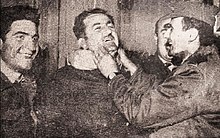








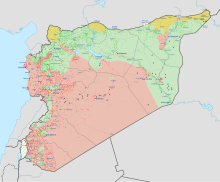
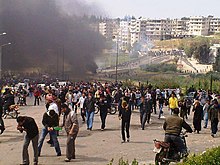

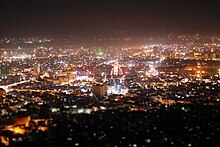
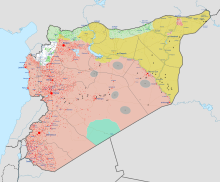

Territories controlled by the Syrian Armed Forces (white), SOR (pink), SNA and Turkey (light green) SDF and the United States (yellow), IS (grey), the SFA and the United States (teal).






